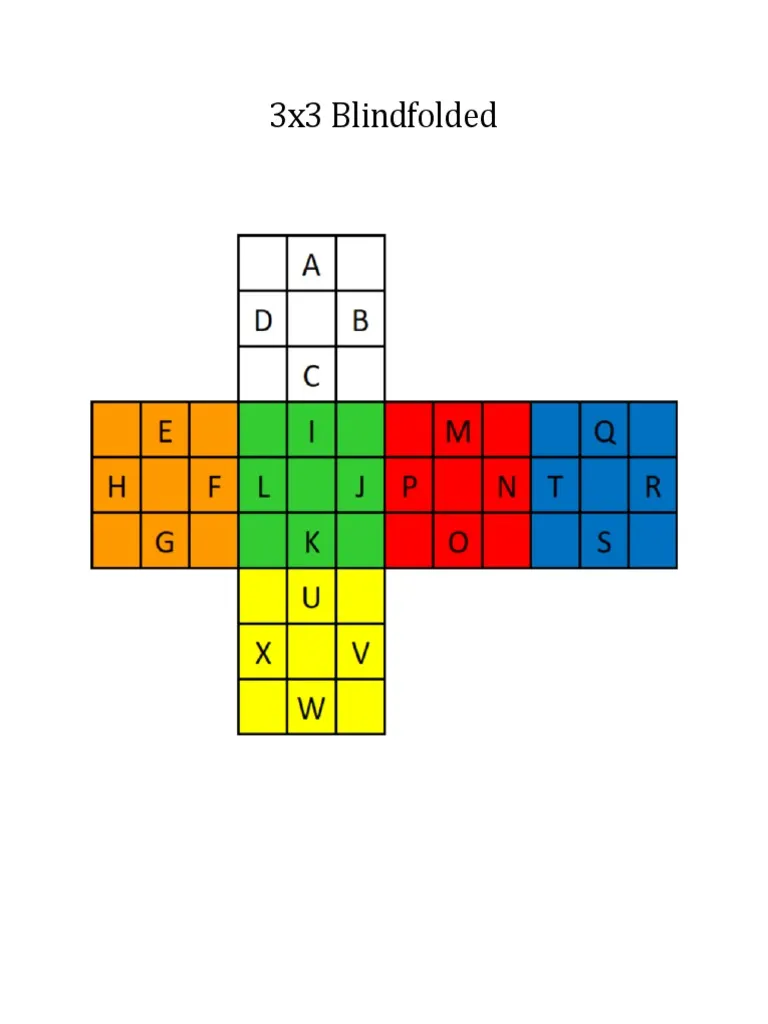The Ultimate Guide to Blindfolded Rubik's Cube Memorization
Part 1: The Fundamentals of Blindfolded Solving
A. Beyond the Puzzle: The Mind-Game of Blindfolded Cubing
Blindfolded cubing (3BLD) is a mental challenge, not magic or a "photographic memory" as many believe. It is a structured, methodical skill based on memorization and planning. The solve begins with a memorization phase, where the solver mentally maps misplaced pieces and plans the solution before the blindfold is applied. The goal is to solve the cube in the mind first, then execute the moves.
B. The Old Pochmann Method: A Beginner's Cornerstone
The Old Pochmann (OP) method is a great starting point for beginners. It's a "one-piece-at-a-time" approach that solves edges and corners in two separate phases. The method uses a "buffer" piece—a fixed location on the cube—as the starting point for all swaps. A common buffer for edges is the Up-Right (UR) sticker, and for corners, it's the Left-Back-Up (LBU) sticker. Memorization involves tracing a "cycle" by following the path of each piece: where the buffer piece goes, where that piece goes, and so on, until the chain leads back to the buffer.
Part 2: The Language of the Cube: Speffz Notation
A. What is Speffz Notation?
Speffz is a standardized lettering scheme that assigns a unique letter to each non-center sticker on the cube, making it a shared language for blindfolded solvers. This system simplifies the memorization process by replacing long descriptions with single letters. The scheme follows a logical, predictable structure: letters are assigned in a clockwise direction across the faces in the order Up, Left, Front, Right, Back, and Down (ULFRBD). This systematic approach makes it a powerful mnemonic tool, reducing the need for rote memorization.
B. Deciphering the Scheme: A Comprehensive Guide
For a 3x3 cube, Speffz uses 24 letters (A-X) for all corner and edge stickers. The standard convention uses a Western color scheme (white on top, green in front). The tables below provide the letter assignments. For the D face, an x2 rotation is needed to set the correct orientation. The letters, like QU SR NX IV PR DE, are the raw data for memorization.
Speffz 3x3 Letter Assignments – Corners

Speffz 3x3 Letter Assignments – Edges

Part 3: The Art of Memory: Crafting Your Mental Toolkit
A. From Letters to Words: The Mnemonic Power of Associations
After tracing a cycle of Speffz letters, a technique called "chunking" makes the data easier to remember. Letters are grouped into pairs (e.g., QU and SR) and associated with memorable words or images. The most effective associations are personal, vivid, and even bizarre. While pre-made word lists exist, creating your own connections is more reliable, turning memorization into creative storytelling rather than rote learning.
B. The Mind's Stage: The Memory Palace Technique
The Method of Loci, or "Memory Palace," is an ancient technique for organizing mnemonic images. It involves associating information with specific locations in a familiar place, like a home. A solver creates a mental path through the location and places an image for each letter pair at a distinct "station" (locus). For example, a story like "QUick StaR NeXus IVy PRint DEad" could be placed in a room: a "QUick StaR" on the bed, a "NeXus" on the desk, etc. This method helps prevent "palace overlap," where memories from different solves get confused, especially during multi-blind attempts.
Part 4: From Memo to Solve: Practical Application and Advanced Insights
A. Navigating the Memo Process: Cycles and Parity
After learning Speffz and mnemonic techniques, a solver traces the cube's state by following cycles from the buffer piece. If unsolved pieces remain after a cycle is complete, the solver "breaks" into a new cycle by choosing a new unsolved piece. The concept of "parity" is a key diagnostic tool. The number of memorized letters for edges and corners must always be both even or both odd. If they are not, it signals a memorization error, turning parity into a useful self-check to correct mistakes before the solve begins.
B. The Execution Phase: The Final Act
The execution phase begins after memorization, with the blindfold on. Edges are solved first, then corners. The process uses "setup moves" to bring each target piece to the buffer location, where a swap algorithm is performed. The setup moves are then reversed. These moves must be chosen carefully to avoid disrupting other pieces in the cycle. If both the edge and corner sequences have an odd number of letters, a parity algorithm is performed between the two phases to correct the cube's orientation.
C. A Roadmap to Mastery: Practice and Pitfalls
Mastering blindfolded solving requires patience and a structured approach. Beginners often make psychological mistakes like rushing or getting discouraged. To avoid these, experts recommend a specific practice roadmap:
- Start Slow: Focus on accuracy over speed. Speed will improve with practice.
- Practice Separately: Practice memorization and execution as separate skills before attempting a full solve.
- Pseudo-Solves: Practice with your eyes closed but without a blindfold at first. This allows you to peek and identify mistakes without full frustration.
- Embrace Mistakes: Every mistake is a valuable learning opportunity. Analyzing them is the fastest way to improve.
Conclusion: The Journey of the Blindfolded Solver
Blindfolded solving is not magic; it's a systematic skill. It starts with the Old Pochmann method and the Speffz notation. Memory techniques, like turning letters into images and using a Memory Palace, are then used to organize the solve. With an understanding of cycles, parity, and setup moves, and with deliberate practice, this challenging discipline becomes an attainable and rewarding skill.
Published on 2025-08-14